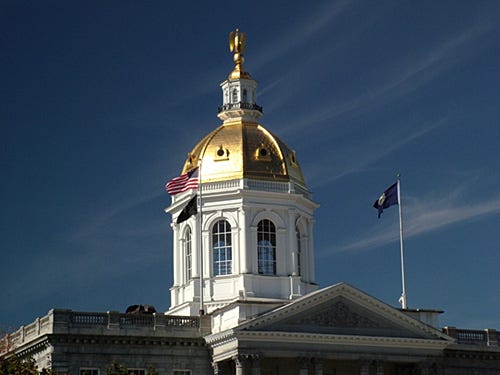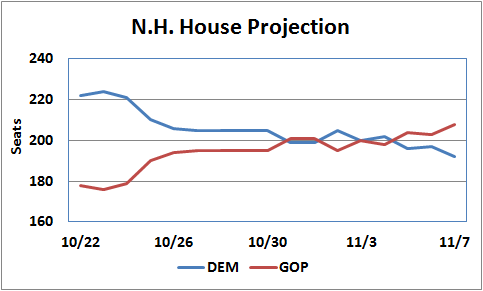
When we last took a detailed look at our model projecting the electoral results for the New Hampshire House, the third presidential debate between Hillary Clinton and Donald Trump had just concluded and Clinton had opened up her largest lead in national polling since before the party conventions.
It turned out to be the high-water mark for her campaign. Six days later, FBI Director Comey made the fateful announcement that his agency was investigating a new batch of messages from Clinton’s private email server and her polling numbers began to slide.
Our final House projection, published on election eve, reflected the change in national mood and predicted Democrats would fall short of the majority, shedding 30 seats from the projection just 16 days earlier.
When the election was over and all of the recounts were completed, Republicans had held onto their House majority with a 226-174 seat advantage, 18 more seats than our final projection of a 208-192 Republican majority.
Our model does not attempt to measure the strengths or weaknesses of individual candidates or their campaigns and does not project results for individual House races. Rather, it is based on just two variables, a partisan analysis for each of the state’s 204 House districts and national polling data.
Polling this year was a mixed bag. While the presidential forecasts were spectacularly wrong, the national polling was pretty accurate. On election day, the RealClearPolitics average had Clinton leading Trump by a 3.2 percent advantage. As the last votes are being tallied, she holds a 2.0 percent lead in the popular vote.
National generic congressional polls, which were the basis for our model, indicated an even closer contest. The final RealClearPolitics average for the generic congressional vote had Democrats up by a negligible 0.6 percent advantage.
In contrast, polling in individual states systematically underestimated Trump’s strength, particularly in the Midwest and Northeast. The New York Times calculated that state polling errors in 2016 were the largest in decades.
New Hampshire was no exception. The final Granite State Poll conducted by the UNH Survey Center between November 3 and November 6, gave Democrats a 46-40 point lead among likely voters when asked which party’s candidate they planned to support for the New Hampshire House.
Based on those results, the UNH survey team projected Democrats would win a majority of the seats in the House, taking 207 seats to 193 seats for Republicans.



